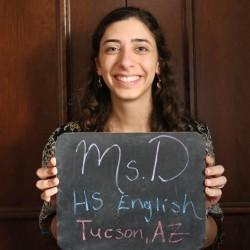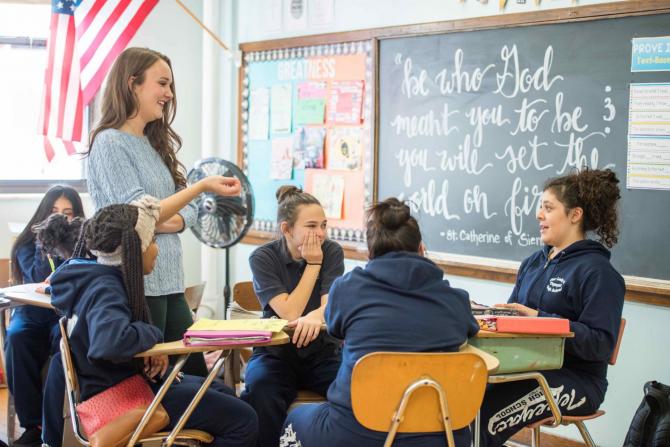Lessons in Literacy // Defining Poetry and Constructing Meaning with High Schoolers

For this installment of the Lessons in Literacy series, the CLE is pleased to spotlight an incredible educator, Dana Deradoorian. Ms. Deradoorian is a member of AmeriCorps and teaches English Language Arts at St. Augustine Catholic High School in Tucson, AZ. She graduated from the University of Notre Dame and is serving her second year as an ACE Teaching Fellow. She is a candidate for a Master’s in Education from the University of Notre Dame.
Teachers periodically contribute to the Lessons in Literacy series on the CLE blog. Through this series, teachers share their classroom successes and innovative ideas.

High schoolers are some of the most brilliant, creative beings on the planet. They are funny and inspiring (while often tired and sometimes a bit snarky). As a high school English teacher, it is easy to get bogged down in the demands of time while planning units, lessons, and activities; it feels like we are always trying to move swiftly onto the next chapter, the next book, the next standard. Sometimes, though, in the midst of this urgent transferral of knowledge, we can miss opportunities to hear sincere and unfiltered thoughts from our truly brilliant students. In a recent unit centered on poetry, I wanted to create an intentional space for my students to have an access point into a rather complicated question: what is poetry?

It’s a question with no real answer, of course—or rather, it is a question with an infinite number of responses, as poetry includes an incredible variety and diversity of texts. In the earlier part of our unit, my students read a wide range of poets, from Shakespeare to Tupac. Then, they analyzed everything from meter to tone, and they wrote a number of different poems on their own. Finally, my students began to prepare for a final performance assessment that asked them to engage with pop songs as examples of poetry.

However, after talking with a group of my students about the work we had done throughout the poetry unit, I was struck by the realization that many of them still had a very rigid view of poetry in their minds (the same view that I had in high school). This view of poetry assumes a certain flatness of poems, one in which poets exist on some dramatically heightened plane from the rest of us mere mortals. The poems they write are organized into neat little rhyming stanzas with some old-fashioned words and speak dolefully of abstract, unapproachable ideas. As my class marched through so many different types of poetry and analysis techniques, we lost some of the wonder that comes from merely experiencing a new poem and finding a perfectly unexpected word placement or getting stuck on a particular punctuation choice.
I decided to plan an extension lesson where I could show my high schoolers that poetry could still surprise them. I also wanted to raise my students’ voices in dialogue with one another to construct their own definitions of poetry. I was inspired by the remembrance of an especially wonderful discussion in my ELA Methods class this past summer with Drs. Mike and Kati Macaluso. As part of an activity in the class, our wonderful professors asked us what the difference between a prayer and a poem was. I was struck, at the time, of the brilliant experience of being challenged to defend something that I thought was simple and only then realizing its immense complexity. What emerged out of that inspired memory resulted in one of my favorite lessons of this school year, and I got to hear the creative insights of my students engaging with a question that continues to puzzle me. Here, I have outlined the steps of the extension lesson I planned for my poetry unit.
Grades: 9-10
Common Core Standards: SL 9-10.1.C-D, RL 9-10.1, RL 9-10.10
Lesson Objectives: Students will be able to defend definitions of what constitutes a poem.
Lesson Materials:
- Compile a collection of random text samples // I gathered a few poems that we had already read in class, but for this lesson, I also found several more poems with nebulous meanings such as "In A Station of the Metro" by Ezra Pound and “This is just to say” by William Carlos Williams. I also collected prayers, excerpts from articles, advertisements, text message conversations, passages from novels, lyrics from pop songs, shopping lists, etc.
Lesson Activities:
1. Categorize the papers // I arranged students in groups of three, and each group received a set of the papers I gathered. The text samples were given without any author or title marking and each was printed on the same size paper. I asked the students to categorize the texts and gave no further instructions, other than to say that they couldn’t have a “random” or miscellaneous category and that they should aim for between 2 and 5 different categories.
2. Observe (and complicate) the madness // I have to admit, I loved seeing how confused many students were by some of the additions. After they read through the papers, though, it wasn’t long before I heard a lot of fierce discussion about how exactly to organize these papers. I circulated silently at first, but then announced my role as devil’s advocate. Many students gravitated toward simple categories at first (rhyming, not rhyming), but even those fell apart as I pointed out incidental internal rhyming in articles. No matter what their categories were, I asked questions and forced them to defend their choices. As time passed, they came up with some incredibly innovative solutions and decisions together. Some students wanted to group the papers based on their primary image or reference: God, nature, material things. This naturally led to texts from a wide variety of genres being grouped together. A few groups wanted to categorize based on emotions, which prompted me to ask them what matters more: the emotion that the reader actually feels upon reading the text, or the emotion that the author intended for the text? I was impressed, as ever, with their insights.

3. A new challenge: poetry or not? // When students were happy with their chosen categories, I had them walk around the room and compare their choices with those of their classmates. Then, they all returned to their original groups, and I asked the groups to decide which papers contained words they could reasonably defend as comprising a poem.
4. Lean into the disagreement // The best part of this activity was when we came together for a class discussion. Students fiercely disagreed about whether or not a certain text should be considered poetry. A student told me that one of the more hotly debated texts was her new favorite poem because it sounded so modern and grounded in today’s world. Unbeknownst to her, it was actually an excerpt from The Pillow Book, an 11th-century travel journal by Sei Shōnagon. In this part of the class, my students were truly constructing and defending their own definitions of poetry, in a much more authentic way than if I had assigned them the essay prompt to “define poetry.” In the end, I assessed the effectiveness of this activity by giving them a brief writing assignment wherein they composed their own definitions of poetry and defended them, with examples from the text set.
Our group reflection on this activity and my students’ attitudes going into their performance assessment convinced me that it had truly shaken them from their prior notions of poetry. They had entered into the dynamic spirit of poetry and actually found accessible, vibrant ideas. We concluded this lesson with more questions than answers, but I felt confident that they were more open to the joy of discovering poetic elements everywhere, now that they had been able to engage with the discovery on their own. I remain firmly passionate about the power of giving students a platform on which to express their own thoughts, particularly when it comes to something as personal as poetry. They will be the poets of the 21st century, and it is so important that they are able to articulate how and why a text is meaningful to them! It is my joy as their teacher to witness those articulations.
Happy reading,
Dana